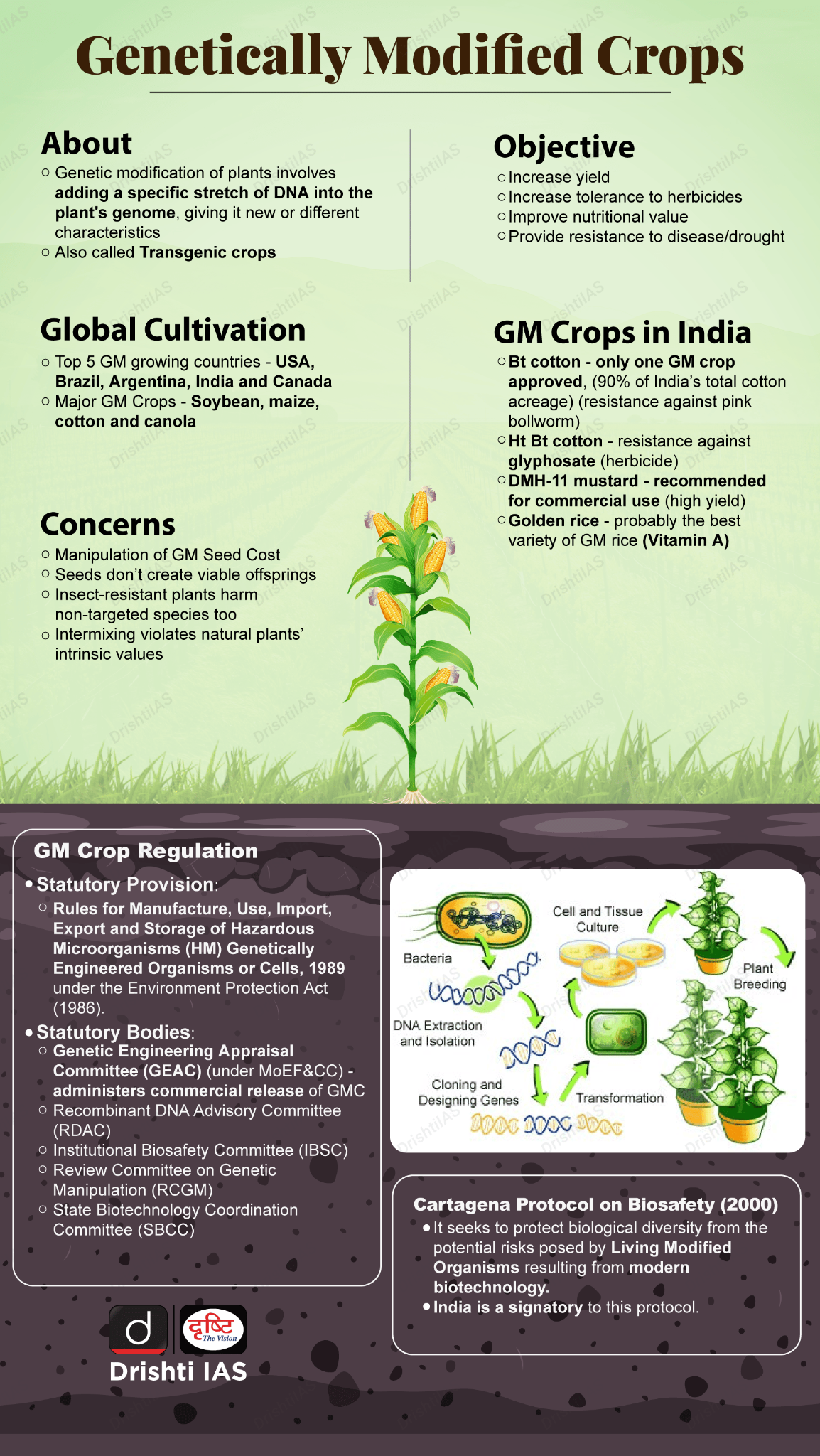Agriculture
Genetically Modified Mustard
- 20 Jan 2024
- 7 min read
For Prelims: Genetically Modified (GM) crops, Herbicide, Resistance, Drought, Bt cotton, Genetic Engineering Appraisal Committee (GEAC), Dhara Mustard Hybrid-11 (DMH-11), ‘Early Heera-2’ mustard, Bacillus amyloliquefaciens,
For Mains: Significance of Genetically Modified Crops in achieving Sustainable Development Goal 2: Zero Hunger.
Why in News?
Recently, the Government of India told the Supreme Court that Genetically Modified (GM) crops such as mustard will make quality edible oil cheaper for the common man and benefit national interest by reducing foreign dependency.
- The Genetic Engineering Appraisal Committee (GEAC) has approved the environmental release of Dhara Mustard Hybrid-11 (DMH-11), a genetically-engineered variant of mustard.
- If approved for commercial cultivation it would be the first genetically modified food crop available to Indian farmers.
India's Demand for Edible oil
- The total edible oil demand of India was 24.6 million tonnes (2020-21) with domestic availability of 11.1 million tonnes (2020-21).
- In 2020-21, 13.45 million tonnes (54%) of the total edible oil demand was met through import worth about ₹1,15,000 crore, which included palm oil (57%), soybean oil (22%), sunflower oil (15%) and small quantity of canola quality mustard oil.
- In 2022-23, 155.33 lakh tonnes (55.76%) of the total edible oil demand was met through import.
- India is the biggest importer of palm oil, which makes up 40% of its vegetable oil consumption.
- India meets half of its annual need for 8.3 MT of palm oil from Indonesia.
- In 2021, India unveiled the National Mission on Edible Oil-Oil Palm to boost India’s domestic palm oil production.
What are Genetically Modified (GM) Crops?
- GM crops are derived from plants whose genes are artificially modified, usually by inserting genetic material from another organism, in order to give it new properties, such as increased yield, tolerance to a herbicide, resistance to disease or drought, or improved nutritional value.
- Earlier, India approved the commercial cultivation of only one GM crop, Bt cotton, but Genetic Engineering Appraisal Committee (GEAC) has recommended GM Mustard for commercial use.
What is GM Mustard?
- Dhara Mustard Hybrid-11 (DMH-11) is an indigenously developed transgenic mustard. It is a genetically modified variant of Herbicide Tolerant (HT) mustard.
- DMH-11 is a result of a cross between Indian mustard variety ‘Varuna’ and East European ‘Early Heera-2’ mustard.
- It contains two alien genes (‘barnase’ and ‘barstar’) isolated from a soil bacterium called Bacillus amyloliquefaciens that enable breeding of high-yielding commercial mustard hybrids.
- DMH-11 has shown approximately 28% more yield than the national check and 37 % more than the zonal checks and its use has been claimed and approved by the GEAC.
- “Bar gene” maintains the genetic purity of hybrid seed.
What is the Genetic Engineering Appraisal Committee (GEAC)?
- The Genetic Engineering Appraisal Committee (GEAC) functions in the Ministry of Environment, Forest and Climate Change (MoEF&CC).
- It is responsible for appraisal of activities involving large scale use of hazardous microorganisms and recombinants in research and industrial production from the environmental angle.
- The committee is also responsible for appraisal of proposals relating to release of genetically engineered (GE) organisms and products into the environment including experimental field trials.
- GEAC is chaired by the Special Secretary/Additional Secretary of MoEF&CC and co-chaired by a representative from the Department of Biotechnology (DBT).
- Presently, it has 24 members and meets every month to review the applications in the areas indicated above.
UPSC Civil Services Examination Previous Year Question (PYQ)
Prelims
Q1. Other than resistance to pests, what are the prospects for which genetically engineered plants have been created? (2012)
- To enable them to withstand drought
- To increase the nutritive value of the produce
- To enable them to grow and do photosynthesis in spaceships and space stations
- To increase their shelf life
Select the correct answer using the codes given below:
(a) 1 and 2 only
(b) 3 and 4 only
(c) 1, 2 and 4 only
(d) 1, 2, 3 and 4
Ans: (c)
- Genetically modified crops (GM crops or biotech crops) are plants used in agriculture, the DNA of which has been modified using genetic engineering methods. In most cases, the aim is to introduce a new trait to the plant which does not occur naturally in the species. Examples of traits in food crops include resistance to certain pests, diseases, environmental conditions, reduction of spoilage, resistance to chemical treatments (e.g., resistance to a herbicide), or improving the nutrient profile of the crop.
- Some potential applications of GM crop technology are:
- Nutritional enhancement – Higher vitamin content, more healthful fatty acid profiles, Hence, 2 is correct.
- Stress Tolerance – Tolerance to high and low temperatures, salinity, and drought, Hence, 1 is correct.
- There is no such prospect that enables GM crops to grow and do photosynthesis in spaceships and space stations. Hence, 3 is not correct.
- Scientists have been able to create certain genetically modified crops which stay fresh for a month longer than usual. Hence, 4 is correct. Therefore, option (c) is the correct answer.
Mains:
Q. What are the present challenges before crop diversification? How do emerging technologies provide an opportunity for crop diversification? (2021)
Q. What are the research and developmental achievements in applied biotechnology? How will these achievements help to uplift the poorer sections of the society? (2021)
Q. How is science interwoven deeply with our lives? What are the striking changes in agriculture triggered off by science-based technologies? (2020)
Q. How was India benefited from the contributions of Sir M. Visvesvaraya and Dr. M.S. Swaminathan in the fields of water engineering and agricultural science respectively? (2019)





